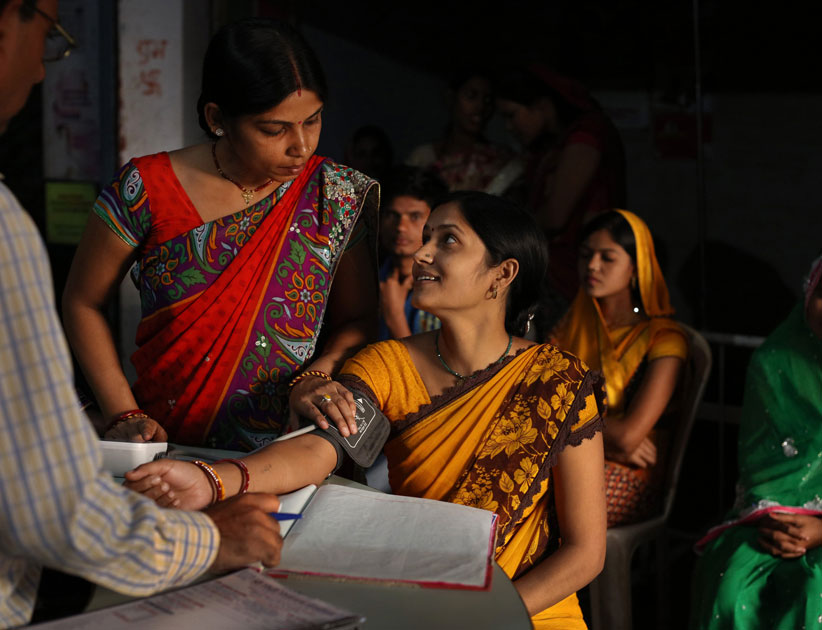
Healthcare
These tools for the healthcare sector can be used to explore gender opportunities, screen potential investments through a gender lens, and advise portfolio companies on how to better integrate gender through their operations and supply chains.
Explore how leading healthcare companies integrate gender into their operations, and the resulting business and social benefits

Briefing: Gender & Healthcare
Innovations in healthcare are as wide-ranging as the conditions they seek to address, with different issues affecting different populations by geographic region, age, sex and other demographic factors. Health systems also vary widely, with resource levels and business models highly contingent on the context. However, in communities around the globe, women’s health remains a key indicator of development, and thus an important focal area of research and service delivery, from universities and public health organizations to local clinics and national hospitals.
The United Nations Development Program’s (UNDP) annual Human Development Report measures numerous gender-related health indicators, for example rates of adolescent births, presence of skilled birth attendants, family planning and contraceptive prevalence, maternal mortality, gender-based violence, and female life expectancy. Many of these metrics serve as strong predictors of overall development and are therefore of national significance. Given the important social and economic outcomes that are possible at a population-level when women access health care information and services, enterprises that target women’s health and well-being represent a high-potential opportunity area for impact investments.
In order to contribute to progress on Sustainable Development Goal #3: (ensure healthy lives and promote well-being for all people at all ages), investments in healthcare must consider how to engage women throughout value chains, and improve outcomes for female customers and patients. In addition to specific sexual and reproductive health services/products for women and girls, essential medicines, vaccines, and affordable primary health services are still in high demand in most emerging market economies. Meeting this demand for healthcare at scale in developing countries will require investment into human capital, health infrastructure, and related private enterprises to spur on such innovations, with women’s participation as a key solution to close talent and access gaps.
Since women also access and benefit from general healthcare differently than men, companies operating in the sector have much to gain through applying a purposeful gender lens across their workforce, from R&D and supply chains to operations and delivery of services/sales. Gender integration across the health sector value chain can deliver a diversity dividend for companies through engaging women as staff members and empowers them to serve women and men more effectively through differentiating products and services for specific customer segments, patient groups and community stakeholders. Specifically:
-
- A gender lens in research and development (R&D) of health products and services can ensure that the needs of female and male consumers are taken into consideration when designing medical facilities, services, or commodities like equipment and pharmaceuticals. Segmented patient research and targeted trials can help companies design gender-smart innovations and product offerings. Gender-smart R&D leads to increased effectiveness for health enterprises, whether that means greater patient reach, increased sales, or better rates of uptake, adherence, and/or behavior change. Considering the diverse needs of women, girls, men, and boys, and marketing healthcare interventions to meet their unique needs and preferences, can improve effectiveness and customer satisfaction, and ultimately advance community health.
- Applying a gender lens in health service delivery enhances healthcare providers’ capacity to serve female and male patients and earn customers’ loyalty. Engaging women to work at all levels as practitioners and in patient-interfacing roles can leverage women’s traditional skills in care provision, as well as meet critical population needs for professional medical care. Especially in contexts where patients may prefer to be seen by doctors and medical officers of their same sex, maintaining a diverse clinical staff is paramount for ensuring patients access the care they need. Engaging women in key roles within health service delivery starts with gender equitable access to STEM education and medical schooling, and also includes recruitment and promotion of women in administrative leadership roles in health systems.
- Gender integration in supporting services may target women’s involvement in healthcare supply chains and logistics, or call for gender-specific marketing strategies and distribution channels that can enable companies to better speak to and reach a diversity of consumers. Employing women in the business processes that undergird the healthcare sector and targeting these services to female customers/patients can help companies access hard-to-reach households, or uncover gender-smart technology solutions that grant women and girls wider access to vital information and services. Additionally, as traditional stewards of care and community well-being, women may be trusted promoters of healthcare products among their peers, and are frequently organized in networks that can link to vast new markets.
Some of the most impactful gender-smart health interventions in emerging economies involve practitioners who bring the treatment direct to the patient, enterprises that leverage technology solutions for greater access and delivery options, and initiatives to ‘right skill’ an efficient workforce by training and dispatching the requisite level of care.
